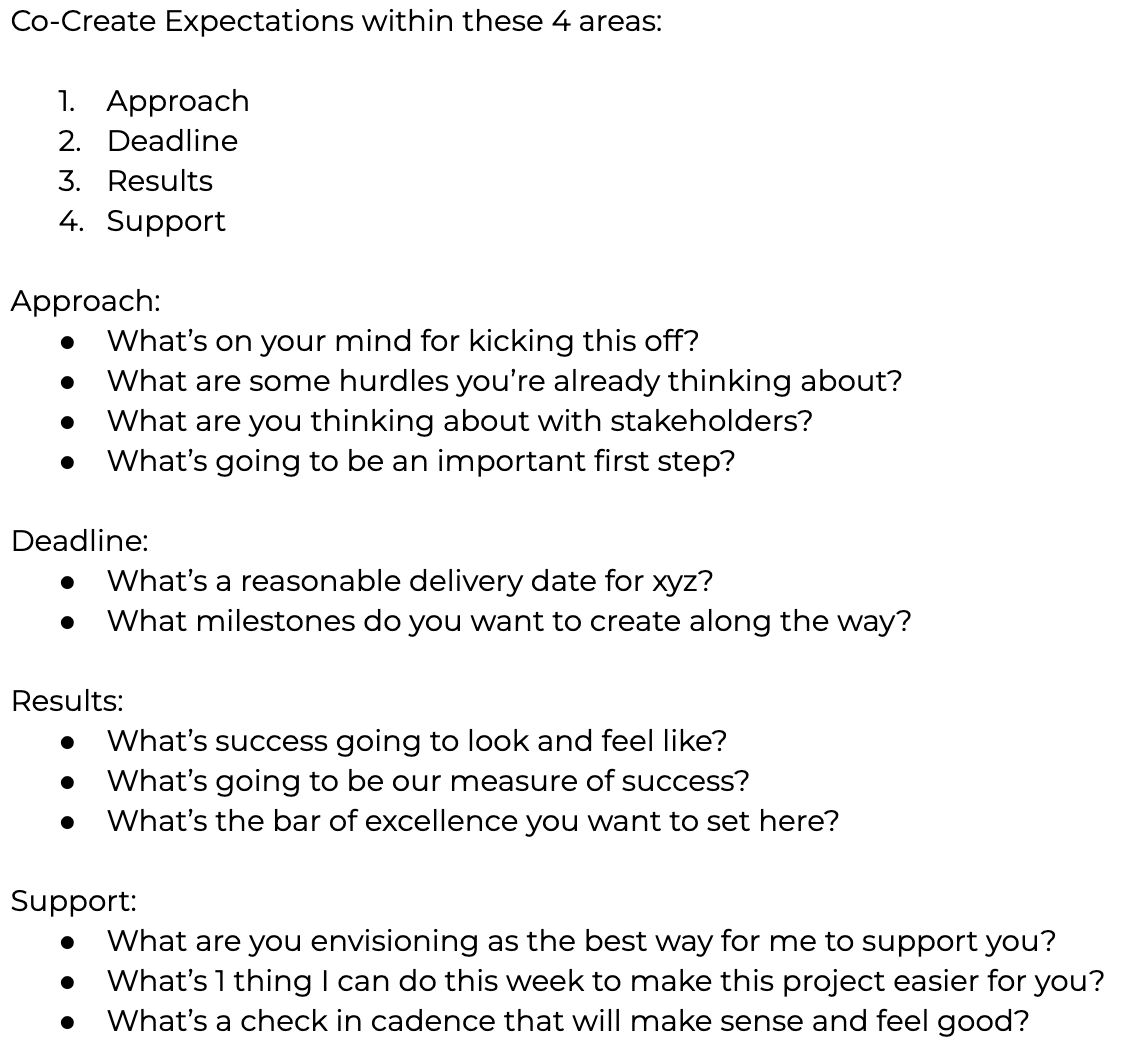Dear Katie: My team doesn't trust our cross-functional partners, help!
6 trust factors to improve cross-functional team trust.
What do you do when your team trusts one another, but they don’t trust their cross functional partners?
Been there?
Yeah, me too!
If my posts are foundational to your career development, consider expensing a paid subscription to unlock more tools and access . Here’s a handy expense request template to help!
Let’s dive in…
The Challenge
I manage a sales team and we have great energy within the team. But when it comes to working with other teams - finance, rev ops, CX - there’s tension and I can’t help saying that we struggle to trust our cross functional partners. I know it sounds bad to admit, I also know I’ve got to get things turned around with these other teams.
Do you have any tips for building trust cross functionally?
Team dynamics are nothing short of tricky, let me offer you some additional tools in your tool belt.
6 Conditions for Trust Within & Between Teams
What I’m going to share comes to us from Squadify, a data-driven platform helping teams accelerate their performance.
Listed here are 6 conditions their research has concluded are critical to creating team trust.
Out of the gates: which ones stand out as being deficient between your team and their cross functional partners?
Deliver on commitments
Strong personal connections
Safe space to share ideas
Right technical skills
Team interests above individual interests
Team speaks with one voice
Hold tight onto your initial reactions, we’ll get into what to do with these 6 in a moment.
And first…
The Role Of The Leader
Forgive the direct message that I’m about the share:
The leader sets the tone. If cross functional relationships are shrouded in tension, our first step is examining the role we might have played in the situation.
A powerful place to start, ask yourself:
What role have I played in the mistrust I’m observing?
Some things I think about:
Which of my actions have inadvertently compromised my team’s opinion of our partners?
What behaviors might I have allowed that have perpetuated the challenge?
What’s my relationship with the leaders of the other teams?
To what extent am I modeling productive collaboration?
It’s highly possible the teams and cross functional partners you’re dealing with are difficult. I get it.
AND, at the same time, we have an opportunity to be proud of the way we show up, particularly in the most difficult of situations.
Pause here: What’s coming up? What are these reflections highlighting for you?
What 1-2 actions can you identify you can take that will help you set the tone for how you want your team engaging across the business?
Actions to Improve Trust Within & Between Teams
I previewed 6 conditions proven to be components to creating trust within teams.
It’s helpful to break these into two phases:
Phase 1 - table stakes
Phase 2 - profound transformation
Let’s look at actions you can take to strengthen each.
Phase 1 - Table Stakes
These 3 are your lower hanging fruit. Without these, it’s no wonder mistrust exists between teams.
1. Deliver on commitments
It’s simple — What’s your Say to Do ratio?
When people say they’ll do something, does it get done? Can you hand something off and know it will be delivered?
Nothing erodes trust faster than not delivering. This is an easy place to start for improving trust within a team and between teams.
Ideas for action:
Accountability Systems - what do you have in place for meaningful follow up on commitments?
Revisit Alignment - what clarity and alignment is there between parties on the deliverables and commitments?
Co-Create Expectations - try the 4 part structure below when you’re kicking off new tasks or cross functional work:
2. Safe space to share ideas
When people speak up, what happens?
Are they met with pushback or curiosity? Is there encouragement and gratitude for speaking up, or does the conversation quickly keep chugging along as though an idea wasn’t just brought up?
A key action for leaders is leaning into inclusion cues in meetings:
Taylor, it looks like your wheels are turning, what would you add to this?
Riley, I’m guessing you have a valuable perspective, what are you thinking?
Charlie, what’s coming up for you on this topic?
And when folks raise a point, or have a counter argument, your positive reinforcement will aid in creating the conditions that will enable safety.
Responding with things like:
Thank you, I appreciate your courage in asking the tough question.
Thank you, it’s a good and important question.
When you notice someone else shuts down, or dismisses an idea, in real time, jumping in and encouraging the other person to continue with their sharing.
3. Strong personal connections
Do folks enjoy one another? What’s the extent to which you and others share elements of who you are outside of work? How often do you hear laughter?
Building connections is typically the starting place when building team trust.
But that’s the problem.
It’s viewed as a starting place, not an evergreen activity that’s important to the health of the team and business.
As the leader, find ways to facilitate ways for people to continue to connect and form meaningful bonds, both within the team, and cross functionally.
Ideas for action:
Guest appearances - invite cross functional partners to your team meetings periodically. Enable them to have the floor and share updates and answer questions.
Cross-team acknowledgement - can you create opportunities to recognize and praise members of other teams? Someone had a baby - is the team congratulating them? Someone ran a marathon - how is the team honoring the accomplishment? Someone won a large deal - is the team celebrating with them?
Intentional icebreakers - leverage these to keep folks personally connected.
Phase 2 - Profound Transformation
Dynamics within and between teams elevate dramatically when the following 3 conditions are true and present.
What areas of opportunity within these do you want to prioritize?
4. Right technical skills
This is likely the place where managers need to be the most active.
When someone doesn’t have the chops for the job, or is under performing, the team knows. They often know it before you do.
Quickly addressing skill gaps. Giving regular action-oriented feedback. Being specific about skill development.
“But Katie, what if there’s someone on another team that we work with that can’t do their job? They don’t report to me, but their lack of ability causes my team to not trust them.”
Yes, you’re not wrong, that does happen.
And go back to this: it’s the leader’s job to create the conditions for success.
What’s the honest, caring, and candid conversation you need to have with their manager?
It’s yet another example of the importance of leaders modeling effective cross functional relationships.
5. Team interests above individual interests
Are folks looking out for themselves? Or are decisions and actions made with a team-first mentality?
With economic and political uncertainty, we’re understandably seeing more individualistic behavior, more folks in self-preservation mode.
Consider how you’re thinking about “the team”:
Cross functional project TEAM
Peer Management TEAM
Direct reporting TEAM
When tensions are high, it’s easy to forget that you’re part of a few different teams at work.
Can you…
Praise moments of putting the team first over individual needs?
Consider leading brainstorming sessions with the team’s goal/perspective as the angle you’re viewing the challenge from?
6. Team Speaks With One Voice
When your team engages with others outside the team, do they present a united front?
Does the team unify behind a shared voice and message?
Unite behind a message, present a united front outside the team, and team trust has a stronger chance of strengthening.
Summary
Trust across teams doesn’t build itself—leaders shape it.
Whether it’s modeling collaboration, addressing missteps, or nudging your team toward shared goals, the way you show up sets the tone.
Start small: pick one condition to strengthen this week. Trust is built in actions, not intentions—and your leadership is the most powerful place to start.
I’m Katie!
I help leaders drive stronger business results through group training & coaching
I'm also a mom, triathlete, & cowgirl who loves country music and good martinis.
Work with Me
Consider adding me into your career development equation.
Live Group Trainings - perfect for managers looking to increase confidence & competence.
1:1 Leadership Coaching - dial into your leadership competencies & tendencies and gain an effective sounding board and action oriented partner.
Accelerate Your Team’s Performance - leverage data & coaching to align and then accelerate how your team works together and how they deliver results.






